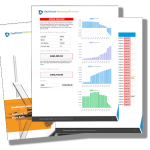What Does IRMAA Stand For? Navigating Medicare
Ever wondered why your Medicare premiums seem to inch up when you least expect it? Welcome to the world of what does IRMAA stand for. It’s not a secret society or a hidden code. Rather, it’s something that could be impacting your wallet right now without you even knowing. Imagine discovering an extra charge on your monthly bill—only this one doesn’t come with a straightforward explanation until you dig deeper.
IRMAA, standing tall as “Income-Related Monthly adjustment Amount,” might sound benign. But don’t let its bureaucratic lullaby fool you; it plays a significant role in determining how much more than the standard premium high-income Medicare beneficiaries pay for Parts B and D. Did I mention that these determinations are based on your income from two years ago? Yes, what you earned then decides what you owe now.
Last year alone saw thresholds adjust dramatically – proving no one is immune to its reach. Yet here we are, most folks unaware of their potential rendezvous with IRMAA until they get hit. Navigating the financial landscape with awareness and foresight can shield us from unforeseen shocks.
Understanding IRMAA and Its Impact on Medicare Premiums
What Is IRMAA?
You’ve probably heard the term IRMAA thrown around when talking about Medicare, but what exactly is it? Let’s clear the air. IRMAA stands for “Income-Related Monthly Adjustment Amount.” Think of it as an extra slice you need to pay on top of your regular Medicare Part B and D premiums if you’re earning more dough than most.
How Is IRMAA Calculated?
The Social Security Administration (SSA) plays detective with your tax returns from two years ago to see if you fit into their bracket for paying this premium. Yep, they look at your adjusted gross income (AGI) and decide whether or not you owe a bit more each month for those essential health coverages under Medicare B and D plans.
This might make some wonder: Why peek into my finances from two years back? Well, that’s how SSA rolls – using historical data to predict current financial status. It feels like time travel without the cool gadgets.
Who Pays IRMAA?
- If rolling in higher incomes was part of your past couple of years’ narrative, chances are you’ll be nodding yes to this question.
- Paying IRMAA, then becomes part of ensuring everyone chips in fairly towards maintaining our healthcare safety net—especially if they can afford it.
- Sounds daunting? Maybe a little; but remember, less than 5% feel its impact directly – showing its tailored focus rather than broad stroke application.
In essence, understanding IRMAA’s calculation is pivotal since it affects how much cash leaves your pocket monthly towards healthcare once retirement sings its siren song. And who knows? With smart planning now, you could navigate away from being caught by surprise later down the line.
This pamphlet from Social Security tells us all we need to know about who ends up paying these additional premiums.
Remember folks, while we may not love every detail about managing healthcare costs as we age, understanding them sure does help make informed decisions. So let’s keep diving deeper together.
Key Takeaway:
IRMAA, or “Income-Related Monthly Adjustment Amount,” means paying extra on Medicare if you’re earning more. It’s decided by your income from two years ago and affects less than 5% of people. Knowing how it works helps manage healthcare costs smarter in retirement.
The Calculation of IRMAA for Medicare Beneficiaries
Factors Influencing IRMAA Calculation
Ever wondered why some folks pay more for their Medicare premiums? It’s all about the Income-Related Monthly Adjustment Amount, or IRMAA, a term that might sound like a distant relative but hits closer to home than you think. What causes the numbers to shift in this equation, then?
- Your yearly income: Yes, it boils down to your modified adjusted gross income (MAGI). The higher it is, the more you’re likely to fork over.
- Filing status: Whether you’re single or married filing jointly affects those thresholds too.
- Social Security Administration’s annual adjustments: Like clockwork, they tweak these numbers. Keeping an eye out helps.
Role of Modified Adjusted Gross Income in IRMAA
Ah yes, MAGI – not magic but sometimes feels just as complex. Here’s the scoop: Your MAGI from two years ago decides if you’ll be paying extra for prescription drug coverage. Picture this: You had a fantastic year financially (kudos.), but fast forward two years and voila – your Medicare premium could see an uptick because of that success. That’s right; Uncle Sam remembers.
